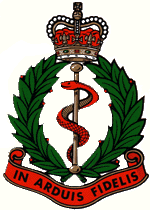RAMC
| Royal Army Medical Corps | |
|---|---|

Cap badge of the Royal Army Medical Corps
|
|
| Active | 1898–present |
| Branch |
|
| Role | Medical support |
| Part of | Army Medical Services |
| Nickname(s) | The Linseed Lancers |
| Motto(s) |
In arduis fidelis (Faithful in adversity) |
| March | Quick: Here's a Health unto His Majesty (arr. A.J. Thornburrow) Slow: Her Bright Smile haunts me still (J Campbell arr. Brown) |
| Anniversaries | Corps Day (23 June) |
| Commanders | |
| Colonel-in-Chief | HRH The Duke of Gloucester KG, GCVO |
| Insignia | |
| Tactical recognition flash |  |
The Royal Army Medical Corps (RAMC) is a specialist corps in the British Army which provides medical services to all Army personnel and their families, in war and in peace. Together with the Royal Army Veterinary Corps, the Royal Army Dental Corps and Queen Alexandra's Royal Army Nursing Corps, the RAMC forms the Army Medical Services.
The RAMC does not carry a Regimental Colour or Queen's Colour, although it has a Regimental Flag; nor does it have battle honours, as elements of the Corps have been present in almost every war the army has fought. Because it is not a fighting arm (i.e. it is non-combatant), under the Geneva Conventions, members of the RAMC may only use their weapons for self-defence. For this reason, there are two traditions that the RAMC perform when on parade:
Unlike medical officers in some other countries, medical officers in the RAMC (and the Navy and Air Force) do not use the "Dr" prefix, in parentheses or otherwise, but only their rank, although they may be addressed informally as "Doctor". Neither do they prefix "Surgeon" in front of their rank as medical officers of the Royal Navy do (although they did until the end of the 19th century).
The RAMC, like every other British regiment, has its own distinctive unit insignia.
Some units wear a brigade stable belt, for example members of 16 Medical Regiment wear a maroon stable belt with two horizontal sky blue lines; the buckle has the brigade Pegasus on it as opposed to the RAMC badge. This unit was formed in 1999 by the amalgamation of 23 Parachute Field Ambulance, whose stable belt they continue to wear, and 19th (Airmobile) Field Ambulance, who previously wore an all-black brigade stable belt.
Medical services in the British armed services go as far back as the formation of the Standing Regular Army after the Restoration of Charles II in 1660. This was the first time a career was provided for a Medical Officer (MO), known as the Regimental Surgeon, both in peacetime and in war. The Army was formed entirely on a regimental basis, and an MO with a Warrant Officer as his Assistant Surgeon was appointed to each regiment, which also provided a hospital. The MO was also for the first time concerned in the continuing health of his troops, and not limited to just battlefield medicine.
...
Wikipedia
